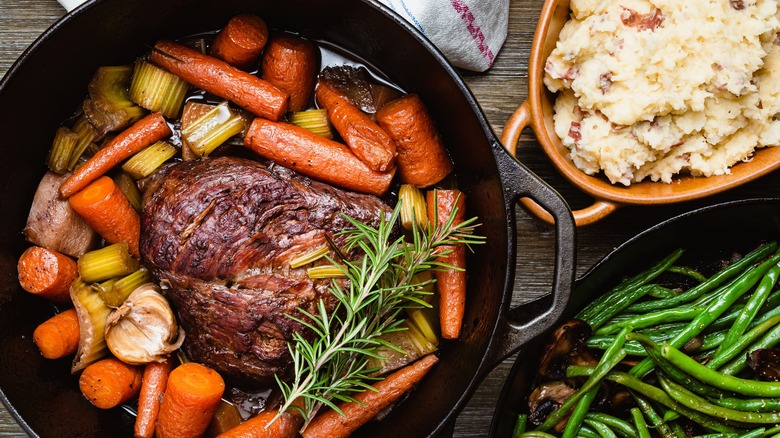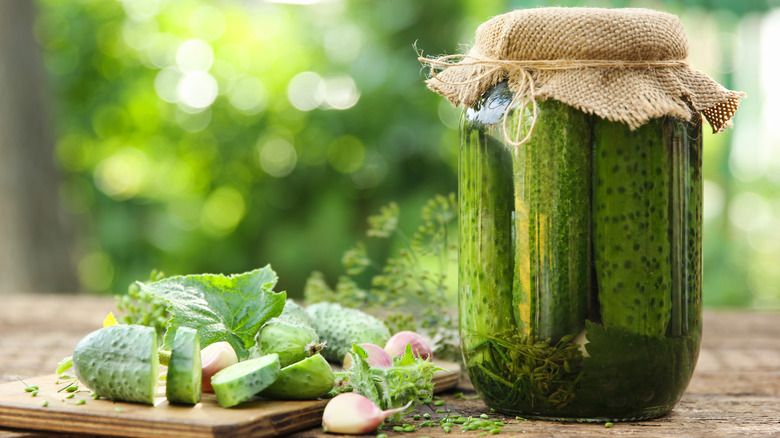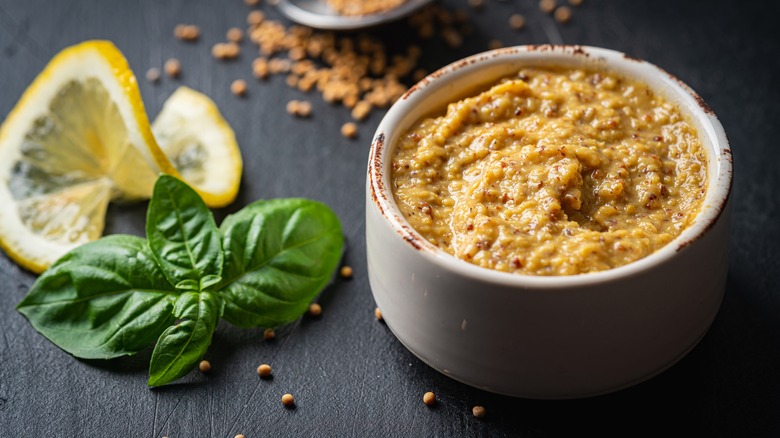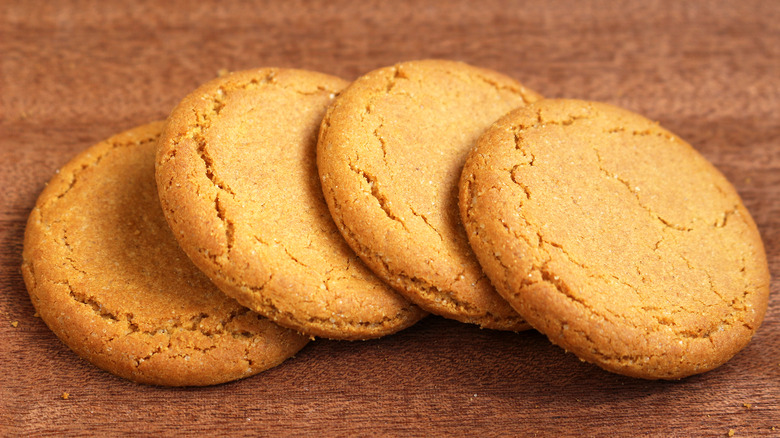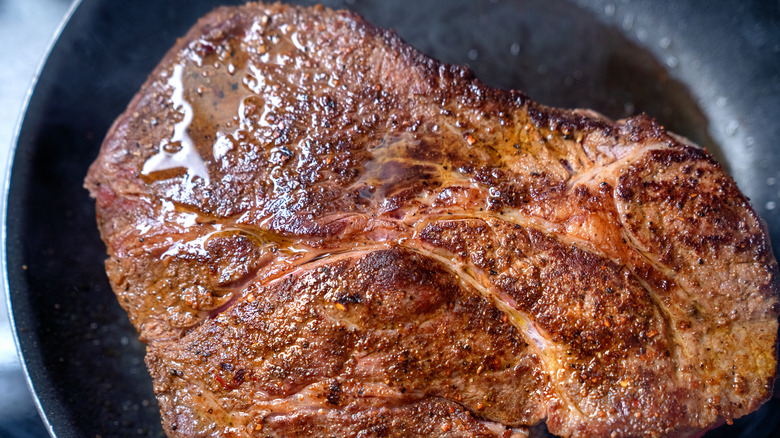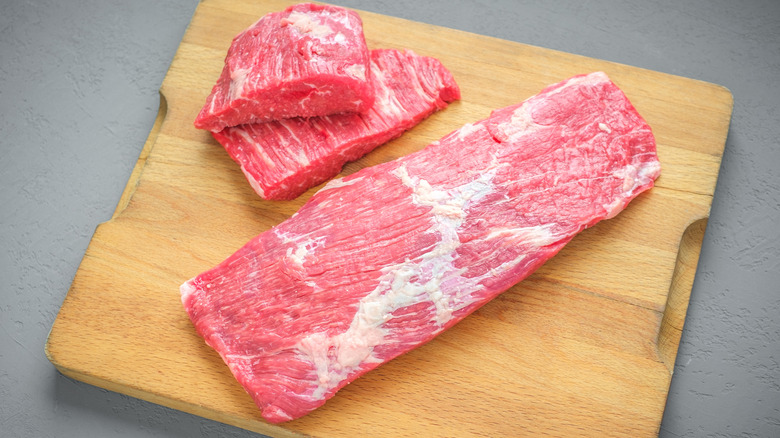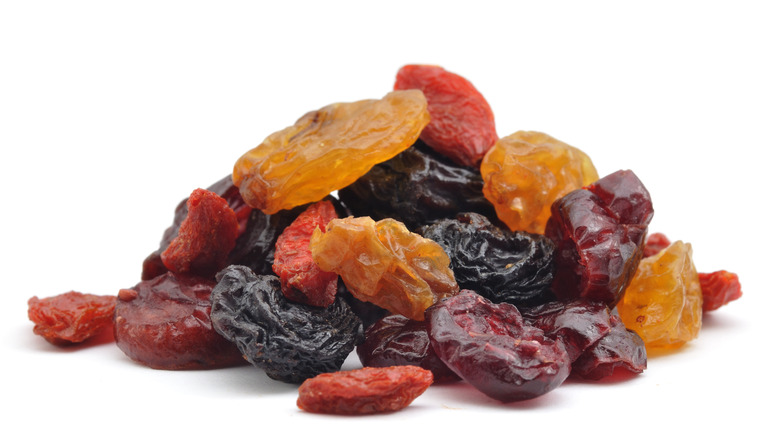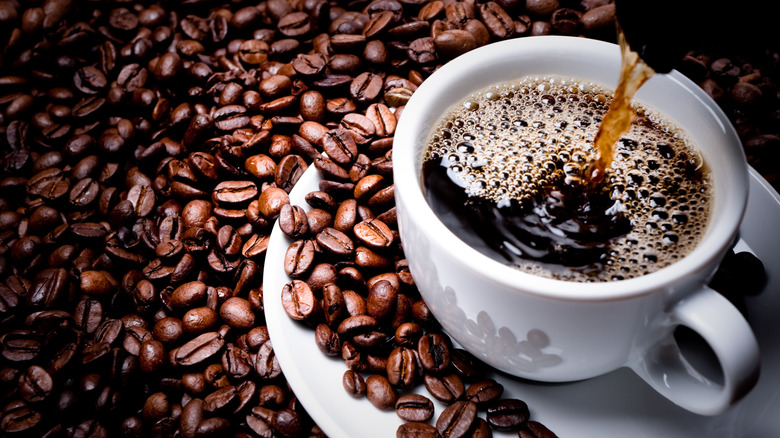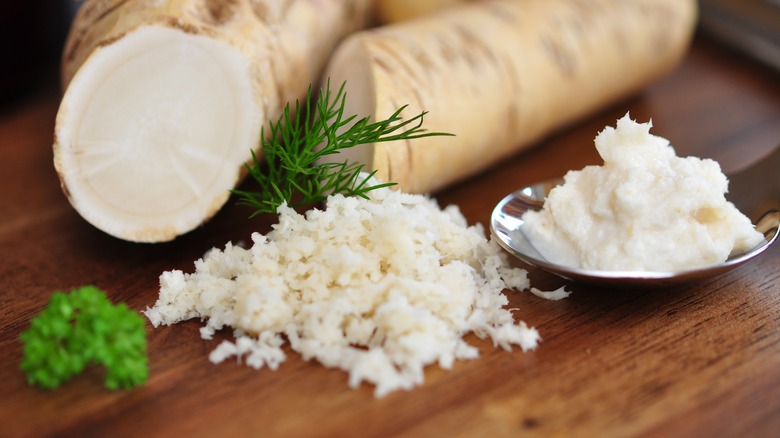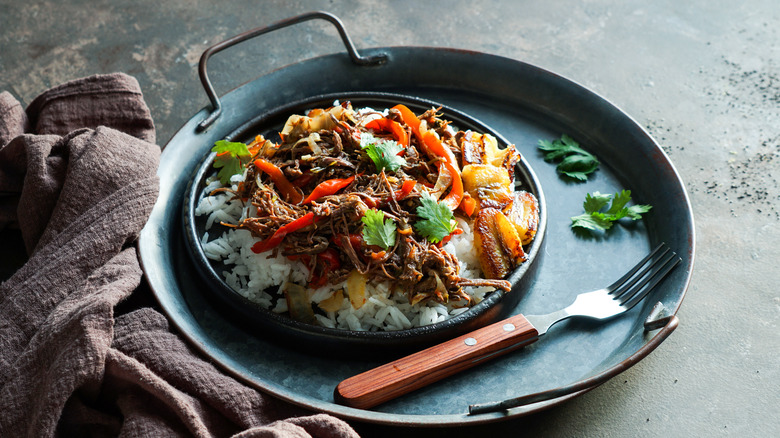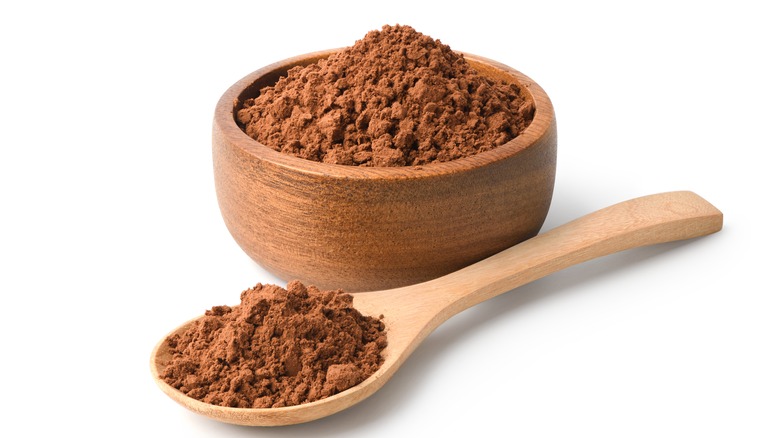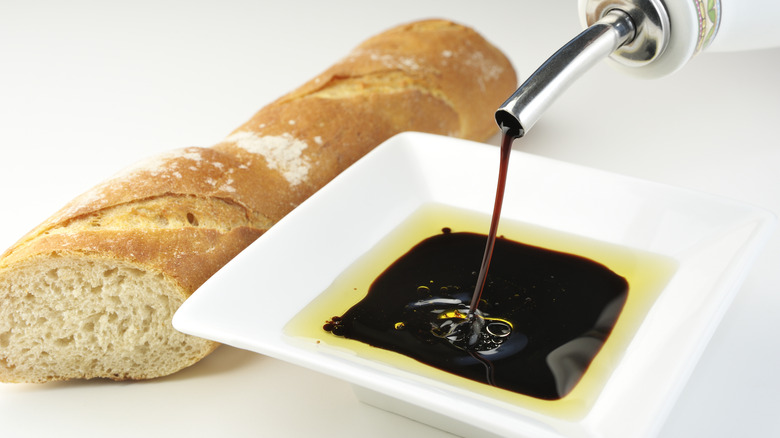13 Ways To Add More Flavor To Pot Roast
Pot roasts are deceptive creations. They look so easy and simple to make, yet they're actually easy and simple to mess up or at least to turn into mediocre globs of wet stuff. But don't feel bad if you've been making so-so pot roasts all your life. A lot of people make mistakes when cooking pot roast. The wrong cut of meat can derail the whole project, while excessive cooking liquid turns it into more of a soup than a pot roast. Other times, a home chef might forget to deglaze the pan, leading to bits of meat getting stuck on the bottom and burning or turning bitter throughout the rest of the cooking process.
Or sometimes the pot roast simply comes out tasting a bit bland. In its most basic form, this dish is just a mixture of meat and vegetables cooked over a long period of time on low heat. There is nothing inherently wrong with that, but it can be less than exciting. But it doesn't have to be that way every time, so we're compiling a list of tips and ingredients that can add more flavor to a pot roast without reinventing the wheel.
Include Coca-Cola
Coca-Cola is not your typical pot roast ingredient, but maybe it should be for several reasons. First of all, the carbonation helps tenderize your beef cut, making sure you don't end up with a gummy or chewy bite. Instead, you get melt-in-you-mouth level stuff. Second, the sweet molasses-like tang of Coca-Cola helps add a caramelized sensation to the pot roast, giving it another layer of flavor.
The ideal type of Coca-Cola for this recipe is the Mexican variety. That's because it's made with real sugar as opposed to high-fructose corn syrup, which will be less effective at achieving that caramelized taste. This caramelization is, in fact, central to the success of the recipe. While we all know that Coca-Cola can make a great pairing for burgers and other meats, it's the vegetables you have to worry about here. Coca-Cola and carrots or parsnips don't necessarily work that well together unless there's some caramelization action going on.
Add dill pickles
To suggest adding cucumbers to a pot roast would be absolute madness. They already taste downright wrong even when slightly warmed, so the thought of cooking them at length seems inhuman. But dill pickles? Now, that just might work. In fact, the zest from the brine can go a long way towards perking up this traditionally even-keeled dish, and a little hint of tang can really bring out the flavor in your favorite cut of meat.
The best way to add your pickles and their brine is at the beginning of the recipe, so they can have time to thoroughly blend in with the meat, juices, and vegetables. Just prepare your beef as you normally would, brown it in your pot, and then add your chopped pickles with some of their juices. Cover your pot and cook on low for as long as needed to create a warm and comfy pot roast.
Use Dijon mustard
If you like mustard, you probably like it on almost anything because it really is a versatile condiment. It works wonders on anything from hot dogs to savory pies to salad dressings. So why not use it on your pot roast? Makes perfect sense! And the good news is that mustard's composition is so solid that it can hold its flavor in a pot roast just fine, even after cooking for several hours.
Adding Dijon mustard to your pot roast is a simple operation. You can include it in your rub at the very beginning, slathering it over your beef cut. Or you can stir a couple of tablespoons of the condiment into your cooking liquid. And here's why it's important to use Dijon instead of other mustards: This type is made with black mustard seeds instead of yellow and white ones, which give it a spicier kick and stronger flavor than yellow mustard. It's also made with white wine in addition to vinegar, giving it an added layer of sophistication. Ultimately, it's not important whether you use the smooth kind or the grainy kind. The former will be easier to incorporate, but the latter will add texture. What's important is that you don't use it with other tangy or briny ingredients, as these could compete with the mustard and overwhelm it.
Make a harissa version
If you're looking for a warm and comforting spice to complement your warm, comforting pot roast, harissa is the spice for you. This pasty blend of Moroccan origin pairs wonderfully with red meats, so you can't go wrong when adding it to your pot roast.
Start by selecting a nice, fatty cut of beef, like a chuck shoulder roast, which lends itself well to shredding and absorbing even more harissa kick. Next, prepare your ingredients for the main event: Lightly toast the cumin, caramelize the lemons, sear the meat on both sides, then roast all of these together, with your broth, in a closed pot at 300 degrees Fahrenheit for about 90 minutes. But you're not done yet. At this point, you can add your vegetables of choice, and they shouldn't turn to complete mush before the day is done. Your dish is ready when the meat comes apart, and the vegetables have been softened through and through. Add some cilantro on top for added freshness — the presence of spice and lemons makes this dish appropriate for hot summer days as well.
Drop in some ginger snaps
You wouldn't be alone in thinking that cookies were for dessert and not for sticking into your pot roast. But if you can bring yourself to put Coca-Cola in your dish, why not try ginger snaps? When life gives you lemons, make lemonade. And when grandma gives you ginger snaps, make pot roast.
What you get in the end is not a sickeningly sweet dish. It's a thicker gravy and a nice ginger flavor that blends well into typical pot roast ingredients, like black pepper and red wine. To make it work, brown your meat as you normally would, but then combine the ginger snaps with vinegar, water, bouillon, and red pepper in a separate bowl. Then lay out your vegetables in a crock pot, place your meat on them, and top it all off with your ginger snap mixture. Then simply cover and cook the roast on low heat for about 10 hours.
Brown the meat first
Pot roast, which often takes the better part of a day to make, is not something you want to rush. When you embark on this lengthy recipe, you should expect to take your time and for results to come slowly. So it should be no extra skin off your back to take the time to brown your meat before roasting it. This is not a step you want to skip. If you're going to commit to such an endeavor, you may as well get it right.
What's so important about the browning step? It's about establishing an extra layer of flavor that will make the difference between a bland pot roast and one that will delight your senses. The step is quick and simple: Just plop your beef cut in your pan or Dutch oven and brown it on all sides, making sure none of the pink interior is visible. And that's it. The key here is to make sure that you then deglaze your pan so that the bits of meat and juices created by the browning doesn't stick and burn but are released to participate in the complex flavor-making procedure that is a pot roast. You can use any liquid to do this, including wine or broth.
Shop for the right cut of beef
If you've only ever had mediocre pot roast, no matter which spices you put into it, you might have to turn your attention to the cut of beef you're using. Because when it comes to pot roast, not all cuts were created equal. For example, leaner cuts of beef, like top round steaks or sirloins, might lead to a chewy or stringy roast. Instead, you'll want to opt for something fatty and tough, like brisket or shoulder steak, meaning something that can withstand the long hours of cooking without drying out.
But don't worry; if you choose the right cut, your meat will not remain tough. The benefit of a tough cut is that the muscle within it will break down into a gelatinous substance that will help keep your meat moist throughout the long cooking process. Meanwhile, the high-fat content of these cuts dissolves and contributes to the thickening and flavoring of the sauce.
Pile on the fruit
We've looked at a few different ways to add sweetness to your pot roast: Coca-Cola and ginger snaps. But if you don't want to use sugar at all, there's another way to add that candied flavor to your pot roast. The natural sugars in fruit lend themselves well to dispersing into sauces. While they won't always retain the original flavor of the fruit, they will certainly get the job done in terms of contributing that sugary kick.
As with meat cuts, not all fruit is suitable to be used in a pot roast. Mainly, you're going to want to use dried fruit. Sugars are more concentrated than their fresh counterparts, so they pack a heftier punch. Their textures are also better suited to long cooking times. A fresh apricot will definitely turn to mush in your Dutch oven, but a dried apricot can remain intact and maybe even rehydrate a little. Other great fruity options include dried prunes or dried figs, and you can always add a touch of unsweetened apple juice for added flavor. In order to incorporate fruit into your roast, you won't even need to leave it in for very long; simply add the fruit in the last hour and a half of the cooking.
Pour in the morning coffee
Coffee pulls double duty when it comes to pot roasts. It's known to bring out the flavor in the meat while also tenderizing it and can also add a pleasantly charred flavor to your roast and surrounding gravy without the danger of burning the meat.
You can use coffee on your roast in two main ways. The Daily Meal recommends brewing a strong cup of coffee and then adding it to your ingredients, pre-layering it in your slow cooker, along with some soy sauce, and then cooking it for at least six hours. Another option is to add ground coffee to your steak rub before you brown it. This method will help you lock in the juices of the beef cut, keeping it moist. Just remember that a high-quality, freshly ground coffee will pack more flavor than a pre-ground variety, but you can still use the pre-made product in a pinch and achieve a similar effect.
Up the ante with horseradish
Strong flavors go hand in hand, and there's no denying that both beef and horseradish are ingredients with strong flavors. And putting them together in a pot roast couldn't be simpler. All you have to do is place your meat and onions in the slow cooker and then top them with your horseradish mixture and cook for several hours.
And if you're not big on spicy flavors, you may still be able to enjoy this recipe. Unlike spicy peppers, which get their kick from a substance called capsaicin, the horseradish burn is relatively short-lived on your tongue. That's because the substance that makes horseradish so virulent is relatively volatile and tends to disperse when exposed to air quickly. Likewise, smaller amounts of horseradish are likely to pack smaller kicks of spice. As such, you can rest assured that any pain you experience from horseradish spice will be brief and that you can attenuate your exposure by taking small bites.
Turn it Cuban
Pot roast as we know it is said to have arrived in the United States by way of cold and rainy New England, brought over by European forebears accustomed to making a wide variety of meat and vegetable stews. That is to say, pot roast has been around for ages, so it stands to reason that it would have branched out and evolved into different forms over the years. One such form is the famous Mississippi Pot Roast, a somewhat spicy version that can trace its roots to 1990s Ripley, Mississippi.
Another top pot roast iteration is a Cuban stew known as Boliche, influenced by Spanish, indigenous, and Caribbean cooking. This is primarily made with eye of round steak, cured pork, potatoes, and vegetables. So far, it sounds very pot roasty, but the main difference here is that in a Boliche, the meat is first stuffed with chorizo or another ham and then marinated for two days in a mixture of citrus, spice, and wine. After that, you're back in familiar New England roast territory. Just brown the meat, add the broth and marinade, and simmer for four hours, adding the vegetables towards the end so they don't overcook.
Blend in some unsweetened cocoa powder
Mexican cuisine has been using cocoa powder in their savory dishes for centuries, and it's about time the U.S. started playing catch-up. It is well established that this ingredient works well with meat and tomato paste, both key ingredients in most pot roasts, so what's holding us back from adding cocoa powder to our stew? Nothing. In fact, cocoa powder can only add to the depth of flavor of your typical pot roast.
And be sure to sift your cocoa powder before you use it. Although it doesn't have to be as precise and lump-free as if you were baking a cake, sifting aerates the powder, releasing more flavor. You should also pay attention to which type of cocoa powder you use, as different varieties will add different flavors to your roast. Natural cocoa powder, for example, tends to be bitter and astringent, while Dutched cocoa powder has an earthier flavor and a higher fat content, which bodes well for a pot roast.
Boost your red wine with balsamic vinegar
Red wine is always going to be a solid pot roast ingredient. It tastes good on its own; you can sip it in between chopping onions, its acidity will break down some of the fat and muscle in the beef, tenderizing the meat, and it'll add depth of flavor to the overall dish. On top of that, balsamic vinegar does all this and more (except for the straight-up drinking part).
Balsamic vinegar will also provide a hint of tang and a bit of sweetness to your pot roast without adding sugar, ginger snaps, Coca-Cola, or any other outlandish sweet ingredient. To use balsamic vinegar in your pot roast, first pick a good quality brand, as the flavor of balsamic vinegar can vary widely depending on the classification. Next, brown your beef cut and remove it from the Dutch oven; add your onions and preferred vegetables, then use the red wine, balsamic vinegar, and broth to deglaze your pan. Lastly, put the meat back in and cook on low heat for at least three hours.
